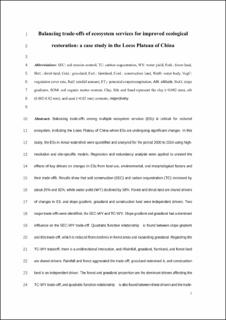| dc.contributor.author | Feng, Qiang | |
| dc.contributor.author | Zhao, Wenwu | |
| dc.contributor.author | Hu, Xiangping | |
| dc.contributor.author | Liu, Yue | |
| dc.contributor.author | Daryanto, Stefani | |
| dc.contributor.author | Cherubini, Francesco | |
| dc.date.accessioned | 2021-09-23T06:52:29Z | |
| dc.date.available | 2021-09-23T06:52:29Z | |
| dc.date.created | 2020-02-29T12:05:41Z | |
| dc.date.issued | 2020 | |
| dc.identifier.citation | Journal of Cleaner Production. 2020, 257 . | en_US |
| dc.identifier.issn | 0959-6526 | |
| dc.identifier.uri | https://hdl.handle.net/11250/2780621 | |
| dc.description.abstract | Balancing trade-off between multiple ecosystem services (ESs) is critical for restored ecosystem, including in the Loess Plateau of China where ESs are undergoing significant changes. In this study, the ESs were quantified by specialized models in Ansai watershed from 2000 to 2014, and regression and redundancy analysis were used to reveal the effects of selected key drivers on ESs and their trade-offs. The results were as follows: (1) soil erosion control (SEC) and carbon sequestration (TC) increased by 17.8% and 82.1%, while water yield (WY) declined by 37.6%. (2) Forest and shrub land are shared drivers, and slope gradient, grassland and construction land were independent drivers. Slope gradient and grassland had a dominant influence on SEC-WY trade-off in 2014. Quadratic function relationship can be found between slope gradient and trade-off. Moreover, reducing forest and expanding grassland can restrain trade-off. (3) There is a unidirectional interaction between TC and WY. Rainfall, grassland, farmland, and forest land are shared drivers. Rainfall and forest aggravated trade-off but grassland restrained tradeoff. Whereas construction land is independent driver. The forest and grassland proportion are dominant drivers affecting TC-WY trade-off in 2014. Quadratic function relationship also can be found between trade-off and forest and grassland. (3) Overall, forest and grassland proportions need to be controlled at 20–30% and 45–60% respectively. We proposed the mode of ecological restoration: taking the contiguous grassland as the matrix, in which the small forest patch with more edges can be set. Our study provides a better understanding for driving mechanism of ESs trade-offs. | en_US |
| dc.language.iso | eng | en_US |
| dc.publisher | Elsevier | en_US |
| dc.title | Trading-off ecosystem services for better ecological restoration: A case study in the Loess Plateau of China | en_US |
| dc.type | Journal article | en_US |
| dc.description.version | submittedVersion | en_US |
| dc.rights.holder | This is the authors' manuscript to an article published by Elsevier | en_US |
| dc.source.pagenumber | 17 | en_US |
| dc.source.volume | 257 | en_US |
| dc.source.journal | Journal of Cleaner Production | en_US |
| dc.identifier.doi | 10.1016/j.jclepro.2020.120469 | |
| dc.identifier.cristin | 1798632 | |
| dc.relation.project | Norges forskningsråd: 286773 | en_US |
| cristin.ispublished | true | |
| cristin.fulltext | preprint | |
| cristin.qualitycode | 2 | |
